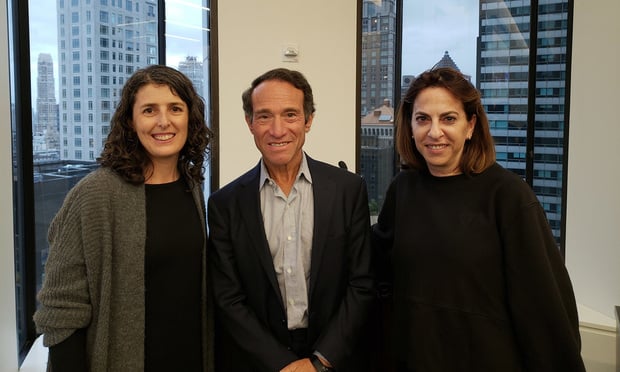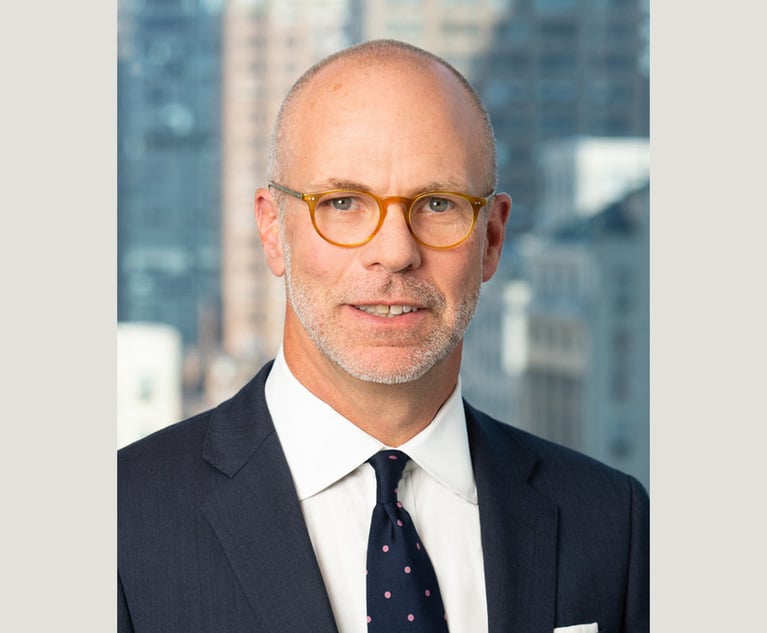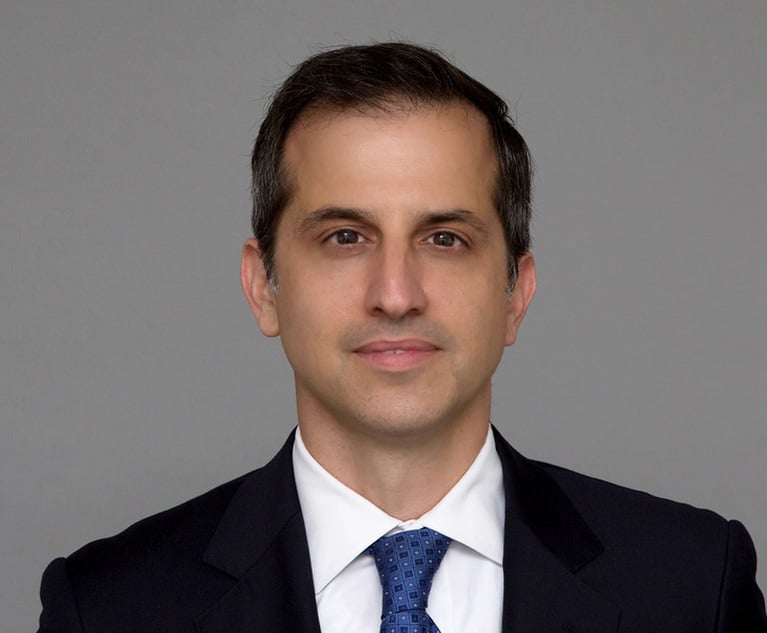After 60,000 Hours, Skadden and Weil Near End of an Innocence Project Backlog
The two Am Law 100 firms and the Innocence Project are close to clearing the group's backlog of thousands of requests for assistance.
October 04, 2019 at 01:55 PM
5 minute read
The original version of this story was published on The American Lawyer
 Olga Akselrod, at left, the director of intake and evaluation for the Innocence Project, and two members of the Innocence Project's board, Weil partner Steven Reiss and Skadden partner Vered Rabia, celebrated the elimination of the Innocence Project's application backlog at an event at Weil on Sept. 6, 2019.
Olga Akselrod, at left, the director of intake and evaluation for the Innocence Project, and two members of the Innocence Project's board, Weil partner Steven Reiss and Skadden partner Vered Rabia, celebrated the elimination of the Innocence Project's application backlog at an event at Weil on Sept. 6, 2019.
The Innocence Project, an organization that uses DNA evidence to exonerate people who have been wrongly convicted, is close to marking a major milestone, clearing a backlog of more than 5,000 applications for help.
Playing a key role in the effort were hundreds of lawyers at Skadden, Arps, Slate, Meagher & Flom and Weil, Gotshal & Manges who have clocked 60,000 hours reviewing prisoners' questionnaires over the past four years.
Olga Akselrod, the intake and evaluation director at the Innocence Project, said the firms have reviewed 5,700 files and are on track to wrap up the questionnaire backlog in its current fiscal year.
The backlog-clearing initiative, the brainchild of Innocence Project board members Vered Rabia of Skadden and Steven Reiss of Weil, wasn't a typical matter involving a one-off representation of a prisoner or indigent defendant that a small team of attorneys could handle. Rather, said Reiss, it was a major project that got help from nearly every corner of the firms—associates and partners, litigators and corporate lawyers, professional staff and even foreign lawyers.
In all, more than 700 attorneys were involved in the effort across the two firms, each of which put in over 30,000 hours on the initiative. Those pro bono hours counted just like billable ones for each lawyer, said Rabia and Reiss. Firm staff also played a key role, setting up the technology infrastructure to transfer case files and reviews among the firms and the Innocence Project, Reiss said.
"You can't get through a backlog of [that many] requests without a lot of lawyers involved," said Reiss, a partner at Weil.
The project got off to a slow start, but with practice, they managed to hone the training process and train more lawyers. Rabia said the initial training was roughly six hours long and included detailed discussion of DNA analysis. Eventually, she said, it was boiled down to a two-hour video, with additional reference materials that lawyers could turn to.
The Innocence Project's focus on reversing wrongful convictions with DNA meant Weil and Skadden volunteers screened applications with a close eye on biological evidence. Convictions for crimes such as fraud or drug dealing tend not to hinge on it. Other cases, such as rape, murder and burglary, often feature a lot of potential DNA evidence that can be key to identifying perpetrators and establishing guilt or innocence, including blood drops, sweaty fabrics or even saliva swabbed from a bite mark.
Case reviewers did some research into public records, like looking up appellate decisions to find answers to questions that prisoners didn't fully answer on their questionnaires. The volunteer attorneys were also trained on how to think through complex scenarios—say, a case with multiple defendants where some biological evidence was inconclusive, or a case where jurors were given scientifically inaccurate descriptions of its significance—and what role DNA analysis might play.
So far, some 900 requests for help from the backlog have moved on to the next stage of review, the Weil and Skadden lawyers said. In those cases, the Innocence Project and firms that support its mission will seek the trial transcript and other records so they can pore over the details and make a decision on whether to take on the case. Each of those reviews could take three months, compared with several hours for the first-stage review, Rabia said.
"It can take years from that initial intake" for the Innocence Project to officially take the case and win exoneration, she said. Some 367 convicted criminals in the U.S. have been exonerated by DNA evidence, according to the organization's website, and just over half of them have been helped by the Innocence Project, which aids federal and state prisoners in most of the country. Groups with similar goals and names exist in a handful of other states and Puerto Rico.
Lawyers at Weil and Skadden continue to help the Innocence Project with its evaluation of applications. More than 2,000 people write to the group every year seeking help, and many of them go on to fill out a detailed questionnaire.
"Skadden and Weil have essentially become a standard part of the Innocence Project's intake process," said Akselrod, the IP's intake director. "It's just really been incredible for improving the efficiency of the process and allowing us to much more quickly find people that we are able to help and at least get back to and give closure to people we are not able to help."
The Weil and Skadden partners expressed hope that their firms' work with the Innocence Project could lay the groundwork for similar large-scale pro bono efforts. Some charitable organizations have been hesitant to embrace Big Law, worried that they will sink more resources into training outsiders than they will get in return, but buy-in from both the Innocence Project and law firm leaders was key, Reiss said.
"The bigger-picture point, and this is really critical, is that major firms have mass resources," Reiss said. "If you put the effort, going in, into really figuring out how to educate people … you can get enormous bang for your buck."
This content has been archived. It is available through our partners, LexisNexis® and Bloomberg Law.
To view this content, please continue to their sites.
Not a Lexis Subscriber?
Subscribe Now
Not a Bloomberg Law Subscriber?
Subscribe Now
NOT FOR REPRINT
© 2025 ALM Global, LLC, All Rights Reserved. Request academic re-use from www.copyright.com. All other uses, submit a request to [email protected]. For more information visit Asset & Logo Licensing.
You Might Like
View All
2024 Marked Growth On Top of Growth for Law Firm Litigation Practices. Is a Cooldown in the Offing for 2025?

Big Company Insiders See Technology-Related Disputes Teed Up for 2025

Litigation Leaders: Jason Leckerman of Ballard Spahr on Growing the Department by a Third Via Merger with Lane Powell
Trending Stories
- 1Chief Judge Joins Panel Exploring Causes for Public's Eroding Faith in NY Legal System
- 2Pogo Stick Maker Wants Financing Company to Pay $20M After Bailing Out Client
- 3Goldman Sachs Secures Dismissal of Celebrity Manager's Lawsuit Over Failed Deal
- 4Trump Moves to Withdraw Applications to Halt Now-Completed Sentencing
- 5Trump's RTO Mandate May Have Some Gov't Lawyers Polishing Their Resumes
Who Got The Work
J. Brugh Lower of Gibbons has entered an appearance for industrial equipment supplier Devco Corporation in a pending trademark infringement lawsuit. The suit, accusing the defendant of selling knock-off Graco products, was filed Dec. 18 in New Jersey District Court by Rivkin Radler on behalf of Graco Inc. and Graco Minnesota. The case, assigned to U.S. District Judge Zahid N. Quraishi, is 3:24-cv-11294, Graco Inc. et al v. Devco Corporation.
Who Got The Work
Rebecca Maller-Stein and Kent A. Yalowitz of Arnold & Porter Kaye Scholer have entered their appearances for Hanaco Venture Capital and its executives, Lior Prosor and David Frankel, in a pending securities lawsuit. The action, filed on Dec. 24 in New York Southern District Court by Zell, Aron & Co. on behalf of Goldeneye Advisors, accuses the defendants of negligently and fraudulently managing the plaintiff's $1 million investment. The case, assigned to U.S. District Judge Vernon S. Broderick, is 1:24-cv-09918, Goldeneye Advisors, LLC v. Hanaco Venture Capital, Ltd. et al.
Who Got The Work
Attorneys from A&O Shearman has stepped in as defense counsel for Toronto-Dominion Bank and other defendants in a pending securities class action. The suit, filed Dec. 11 in New York Southern District Court by Bleichmar Fonti & Auld, accuses the defendants of concealing the bank's 'pervasive' deficiencies in regards to its compliance with the Bank Secrecy Act and the quality of its anti-money laundering controls. The case, assigned to U.S. District Judge Arun Subramanian, is 1:24-cv-09445, Gonzalez v. The Toronto-Dominion Bank et al.
Who Got The Work
Crown Castle International, a Pennsylvania company providing shared communications infrastructure, has turned to Luke D. Wolf of Gordon Rees Scully Mansukhani to fend off a pending breach-of-contract lawsuit. The court action, filed Nov. 25 in Michigan Eastern District Court by Hooper Hathaway PC on behalf of The Town Residences LLC, accuses Crown Castle of failing to transfer approximately $30,000 in utility payments from T-Mobile in breach of a roof-top lease and assignment agreement. The case, assigned to U.S. District Judge Susan K. Declercq, is 2:24-cv-13131, The Town Residences LLC v. T-Mobile US, Inc. et al.
Who Got The Work
Wilfred P. Coronato and Daniel M. Schwartz of McCarter & English have stepped in as defense counsel to Electrolux Home Products Inc. in a pending product liability lawsuit. The court action, filed Nov. 26 in New York Eastern District Court by Poulos Lopiccolo PC and Nagel Rice LLP on behalf of David Stern, alleges that the defendant's refrigerators’ drawers and shelving repeatedly break and fall apart within months after purchase. The case, assigned to U.S. District Judge Joan M. Azrack, is 2:24-cv-08204, Stern v. Electrolux Home Products, Inc.
Featured Firms
Law Offices of Gary Martin Hays & Associates, P.C.
(470) 294-1674
Law Offices of Mark E. Salomone
(857) 444-6468
Smith & Hassler
(713) 739-1250







